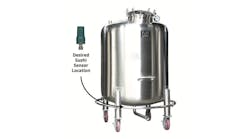The PPG Lake Charles, La., facility is one of the world's largest producers of chlorine, caustic soda and vinyl chloride. The site always is looking for operating economies and views more efficient control of its chemical processes as crucial for achieving many savings. So, the plant has been breaking new ground in the past few years, using wireless communications to obtain more high-value measurements than operators ever dreamed possible — allowing them to respond quickly and effectively to changing process conditions.
The case for wireless was compelling because, in a well-established plant like this, it's both very expensive and time-consuming to get new measurement points online using conventional instrumentation. The cost for introducing wired instruments in many remote areas of the 765-acre site is prohibitive; wiring would run from $20/foot to many times that depending on the amount of engineering and construction involved. Wireless devices now supply data from numerous points that never could have been justified otherwise.
Thanks to these devices, the plant has achieved savings of at least $500,000 over the past two-and-one-half years.
For example, operators use wireless information daily to control steam header temperatures across the entire site, watching for cold spots and making load balancing and sharing adjustments to maintain superheated steam plant-wide.
Wireless Initiative
PPG formed a cross-functional team in January 2005 with six persons from the Lake Charles plant and three from corporate IT to investigate wireless protocols for their utility, reliability, safety and security. This led to a written proposal in mid-2005 for a wireless pilot installation; the first wireless effort started in early 2006 with WiFi and WiMax installations. It was thought that WiMax could be used to blanket the plant with video cameras to monitor key locations — but this initiative was abandoned, partly due to the high cost of WiMax stations and partly due to lack of compatible products.
In early 2006, the focus instead turned to blanketing the plant with hundreds of WiFi access points rather than two or three WiMax.
The plant installed points from January 2006 to April 2007 in "A Caustic," one of three units producing sodium hydroxide. Although the points were supposed to be weatherproof, they couldn't withstand the industrial environment. At that time no vendor was making true industrial WiFi access points. However, the site now has more than 70 WiFi access points and, in the future, the entire facility, including parking lots, will be WiFi-friendly.
In the meantime, the plant established automated long-distance wireless communications with remote brine fields that are eight to 13 miles away. It later replaced the original WiMax stations with proprietary 5.9-gHz access stations — eliminating telephone lease line costs of $35,000 to $40,000 per year and enhancing personal productivity.
The learning continued via investigating and testing every wireless system available. Along the way, the wireless team adopted the PPG Corporate IT security policy calling for WPA2 encryption and authentication.
Successful Test
Near the end of 2005 the plant agreed to serve as a beta test site for Emerson's early wireless transmitters. It established in A Caustic a small Smart Wireless network, which ran for several months. At one time, that unit boasted 900-MHz networks from Emerson and a second supplier, plus WiFi and WiMax; coexistence never was an issue.
Early prototypes used existing instrument housings modified simply by having holes drilled, O-rings affixed and antennas attached to the wireless transmitters. All failures stemmed from either water intrusion or low battery voltage. With no sunlight for solar panels, power had to come from batteries. The original ones lasted only about three months, which was satisfactory because this was only a test.
Figure 1-- Always on track: The wireless mesh network
self-organizes around obstacles like moving railcars.
The basic concept of a self-organizing wireless mesh network proved itself in A Caustic, where the infrastructure is extremely dense with pipes, buildings and cranes. Users don’t need to configure the network. Instead, it actually organizes itself in response to plant changes that affect the way radio signals propagate — whether those changes are physical, such as equipment starting or stopping and railcars rolling by, other radio traffic, or due to an outside influence such as a thunderstorm (Figure 1). As a result, there’s no need for preliminary radio frequency (RF) site surveys or assumptions about what the RF characteristics are going to be like at any one time. It simply doesn't make any difference.
Because the RF space can't be controlled, Emerson's Smart Wireless systems are based on the assumption that changes will occur fast and often. The industrial environment is expected to be dynamic with no time for technicians to react. Therefore, the wireless network automatically adjusts. If an obstruction blocks line-of-sight communications, the network finds a new path for transmissions to reach the gateway (receiver).
This works because all field devices are transmitters and repeaters and are a part of the mesh. They are transceivers with an inherent system-level power-saving characteristic. The self-organizing mesh technology significantly reduces requirements for communications infrastructure (fewer gateways) because it allows transmissions to avoid obstacles and adapt to changing conditions in the facility. The network operates perfectly well in very dense plant environments.
A wireless network must take battery life into account. The more frequently a battery-powered instrument updates, the sooner the batteries run down. Setting the devices to a low-power mode can save energy, enabling them to operate for an extended time on one battery. Run times depend on how often the device is used but battery life currently can exceed 10 years by using a low update rate.
A mesh also inherently needs less power than direct connections. For example, to transmit a signal 1,000 feet, two devices, each with a range of 500 feet, in a mesh network don’t require nearly as much power as a single device transmitting over the entire 1,000-ft distance.
The devices also are secure and meet the requirements established by the PPG wireless team. The first of these is encryption with seemingly random symbols that surround each transmission. Even if a message is intercepted, it takes too long to decode to be of use. Encryption keys are changed frequently so anyone trying to read intercepted messages by comparing them won’t be able to break the code before it's changed.
In addition, a transmission is ignored unless it's authenticated — meaning that the sending and receiving devices must recognize one another. A third step is data verification by the receiving device. The authentication and verification rules are built into the devices, so no foreign device can intercept a transmission or send bogus information to the receiving station.
The Emerson devices also feature channel hopping, a built-in protection against jamming of channels by either intentional or non-intentional sources.
Figure 2 -- High reliability: The wireless devices have
provided flawless performance.
The wireless mesh system has proven to be incredibly reliable (Figure 2). After installation and commissioning, everything comes online within five to 10 minutes and seems to be totally flawless. "We put a Smart Wireless gateway out there, start lighting up the sensors, and they talk. I haven’t had to do any maintenance. It just runs," explains Reese Borel, PPG process control specialist.
Numerous Applications
Uses of Smart Wireless at the Lake Charles plant, some of which are in test stage, include:
Steam header temperature profiling. Twenty wireless Rosemount transmitters are profiling temperatures on the 175-lb and 400-lb steam headers across the entire plant. Operators watch these data every day to check for cold spots and adjust steam throughput to maintain superheated steam plant-wide. Saturated steam can harm some pieces of equipment.
Redundant tank level measurement. Eight wireless transmitters now monitor caustic tank levels, providing backup for primary radar level measurements. The wireless information goes from the gateway to the plant distributed control system (DCS), where the logistics operators responsible for transferring material into and out of the tanks use those levels to avoid overfilling. These operators no longer have to manually measure the tanks every shift — instead they do it only about once a month when a deviation occurs between wireless signals and radar readings — typically because the radar units have become coated with salt.
Vibration monitoring of centrifuges. To test the ability of wireless to provide vibration data, four transmitters were very quickly installed on Salt Bird centrifuges. They provide a continuous stream of vibration data back to the control room to help operators determine when maintenance is due.
Deluge valve monitoring. Wireless discrete transmitters are deployed in three areas of the plant alongside existing deluge valves (each of which consists of one water and one air valve). The transmitters monitor for low and high pressures using dual independent sensors, and alerts operators to any problem with the deluge systems.
Tank pressure monitoring. Two wireless pressure transmitters now check tank pressures in a remote area of the plant where no wired path was available.
Wireless tablet PCs. The plant is testing these devices to enable personnel to use the AMS Suite: Intelligent Device Manager predictive-maintenance software to check transmitters, look up information on existing valves or transmitters, and remotely view the DCS screens.
Once a test succeeds, the plant adopts the application. In all of these cases, wireless instrumentation was chosen as the best means to save time and money for PPG while delivering useful data from the field.
A Valuable Start
For a site the size of Lake Charles, retrieving data from some areas via wiring is cost prohibitive. In addition, getting conduit and monitoring instruments into areas like steam headers ranges from very difficult to impossible. Wireless technology delivers important data from measurements that previously couldn't have been made. The plant is continually discovering additional applications for wireless to increase process reliability and improve operations.


